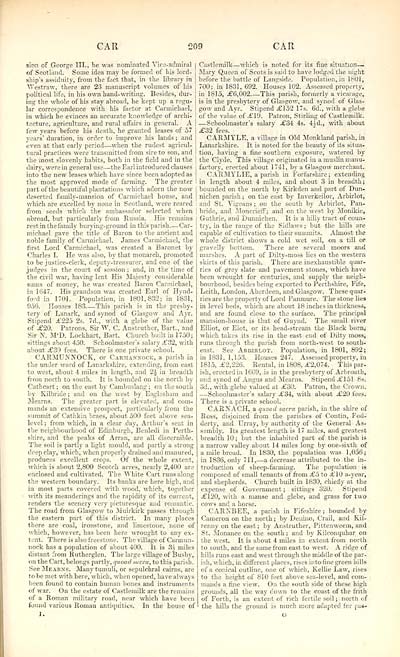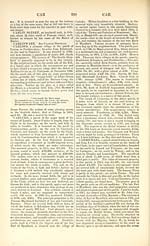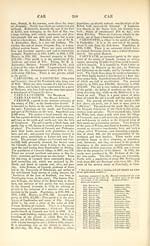Topographical, statistical, and historical gazetteer of Scotland > Volume 1
(289) Page 209 - CAR
Download files
Complete book:
Individual page:
Thumbnail gallery: Grid view | List view

CAR
209
CAR
sion of George III., he was nominated Vice-admiral
of Scotland. Some idea may be formed of bis lord-
ship's assiduity, from the fact that, in the library in
Westraw, there are 23 manuscript volumes of his
political life, in his own hand- writing. Besides, dur-
ing the whole of his stay abroad, he kept up a regu-
lar correspondence with his factor at Carmichael,
in which he evinces an accurate knowledge of archi-
tecture, agriculture, and rural affairs in general. A
few years before his death, he granted leases of 57
years' duration, in order to improve his lands ; and
even at that early period — when the rudest agricul-
tural practices were transmitted from sire to son, and
the most slovenly habits, both in the field and in the
dairy, were in general use — -the Earl introduced clauses
into the new leases which have since been adopted as
the most approved mode of farming. The greater
part of the beautiful plantations which adorn the now I
deserted family-mansion of Carmichael house, and
which are excelled by none in Scotland, were reared i
from seeds which the ambassador selected when [
abroad, but particularly from Russia. His remains
rest in the family burying-ground in this parish — Car-
michael gave the title of Baron to the ancient and
noble family of Carmichael. James Carmichael, the
first Lord Carmichael, was created a Baronet by
Charles I. He was also, by that monarch, promoted
to he justice-clerk, deputy-treasurer, and one of the
judges in the court of session; and, in the time of
the civil war, having lent His Majesty considerable
sums of money, he was created Baron Carmichael,
in 1647. His grandson was created Earl of Hynd-
ford in 1701. Population, in 1801,832; in 1831,
956. Houses 183. — This parish is in the presby-
tery of Lanark, and synod of Glasgow and Ayr.
Stipend £225 2s. 7d., with a glebe of the value
of .£20. Patrons, Sir "W. C. Anstruther, Bart., and
Sir N. M'D. Lockhart, Bart. Church built in 1750;
sittings about 450. Schoolmaster's salary .£'32, with
about £30 fees. There is one private school.
CARMUNNOCK, or Cardian'xock, a parish in
the under ward of Lanarkshire, extending, from east
to west, about 4 miles in length, and 2J in breadth
from north to south. It is bounded on the north by
Cathcart; on the east by Cambuslang ; on the south
by Kilbride ; and on the west by Eaglesham and
Mearns. The greater part is elevated, and com-
mands an extensive prospect, particularly from the
summit of Cathkin braes, about 500 feet above sea-
level ; from which, in a clear day, Arthur's seat in
the neighbourhood of Edinburgh, Benledi in Perth-
shire, and the peaks of Arran, are all discernible.
The soil is partly a light mould, and partly a strong
deep clay, which, when properly drained aud manured,
produces excellent crops. Of the whole extent,
which is about 2,800 Scotch acres, nearly 2,400 are
enclosed and cultivated. The White Cart runs along
the western boundary. Its banks are here high, and
in most parts covered with wood, which, together
with its meanderings and the rapidity of its current,
renders the scenery very picturesque and romantic.
The road from Glasgow to Muirkirk passes through
the eastern part of this district. In many places
there are coal, ironstone, and limestone, none of
which, however, has been here wrought to any ex-
tent. There is also freestone. The village of Carmun-
nock has a population of about 400. It is 3| miles
distant from Rutherglen. The large village of Busby,
on the Cart, belongs partly, quoad sacra, to this parish.
See Mearns. Many tumuli, or sepulchral cairns, are
to be met with here, which, when opened, have always
been found to contain human bones and instruments
of war. On the estate of Castlemilk are the remains
of a Roman military road, near which have been
found various Roman antiquities. In the house of
Castlemilk — which is noted for its fine situation —
Mary Queen of Scots is said to have lodged the night
before the battle of Langside. Population, in 1801,
700; in 1831, 692. Houses 102. Assessed property,
in 1815, £6,002 This parish, formerly a vicarage,
is in the presbytery of Glasgow, and synod of Glas-
gow and Ayr. Stipend £152 17s. 6d., with a glebe
of the value of £19. Patron, Stirling of Castlemilk.
. — Schoolmaster's salary £34 4s. 4|d., with about
£32 fees.
CARMYLE, a village in Old Monkland parish, in
Lanarkshire. It is noted for the beauty of its situa-
tion, having a fine southern exposure, watered by
the Clyde. This village originated in a muslin manu-
factory, erected about 1741, by a Glasgow merchant.
CARMYLIE, a parish in Forfarshire ; extending
in length about 4 miles, and about 3 in breadth;
bounded on the north by Kirkden and part of Dun-
nichen parish ; on the east by Inverkeilor, Arbirlot,
and St. Vigeans ; on the south by Arbirlot, Pan-
bride, and Moncrieff; and on the west by Monikie,
Guthrie, and Dunnichen. It is a hilly tract of coun-
try, in the range of the Sidlaws ; but the hills are
capable of cultivation to their summits. Almost the
whole district shows a cold wet soil, on a till or
gravelly bottom. There are several moors and
marshes. A part of Dilty-moss lies on the western
skirts of this parish. There are inexhaustible quar-
ries of grey slate and pavement stones, which have
been wrought for centuries, and supply the neigh-
bourhood, besides being exported to Perthshire, Fife,
Leith, London, Aberdeen, and Glasgow. These quar-
ries are the property of Lord Panmure. The stone lies
in level beds, which are about 18 inches in thickness,
and are found close to the surface. The principal
mansion-house is that of Guynd. The small river
Elliot, or Elot, or its head-stream the Black burn,
which takes its rise in the east end of Dilty moss,
runs through the parish from north-west to south-
east. See Arbirlot. Population, in 1801, 892;
in 1S31, 1,153. Houses 247. Assessed property, in
1815, £2,226. Rental, in 1808, £2,074. This par-
ish, erected in 1609, is in the presbytery of Arbroath,
and synod of Angus and Mearns. Stipend £151 8s;
3d., with glebe valued at £30. Patron, the Crown.
— Schoolmaster's salary £34, with about £20 fees.
There is a private school.
CARNACH, a quoad sacra parish, in the shire of
Ross, disjoined from the parishes of Contin, Fod-
derty, and TJrray, by authority of the General As-
sembly. Its greatest length is 17 miles, and greatest
breadth 10 ; but the inhabited part of the parish is
a narrow valley about 14 miles long by one-sixth of
a mile broad. Li 1830, the population was 1,056;
in 1836, only 711, — a decrease attributed to the in-
troduction of sheep-farming. The population is
composed of small tenants of from £5 to £10 a-year,
and shepherds. Church built in 1830, chiefly at the
expense of Government ; sittings 320. Stipend
£120, with a mause and glebe, and grass for two
cows and a horse.
CARXBEE, a parish in Fifcshire; bounded by
Cameron on the north ; by Denino, Crail, and Kil-
renny on the east ; by Anstruther, Pittenweem, and
St. Monance on the south ; and by Kilconquhar on
the west. It is about 4 miles in extent from north
to south, and the same from east to west. A ridge of
hills runs east and west through the middle of the par-
ish, which, in different places, rises into fine green hills
of a conical outline, one of which, Kellie Law, rises
to the height of 810 feet above sea-level, and com-
mands a line view. On the south side of these high
groujids, all the way down to the coast of the frith
of Forth, is an extent of rich fertile soil; north of
the hills the ground is much more adapted for pa«-
O
209
CAR
sion of George III., he was nominated Vice-admiral
of Scotland. Some idea may be formed of bis lord-
ship's assiduity, from the fact that, in the library in
Westraw, there are 23 manuscript volumes of his
political life, in his own hand- writing. Besides, dur-
ing the whole of his stay abroad, he kept up a regu-
lar correspondence with his factor at Carmichael,
in which he evinces an accurate knowledge of archi-
tecture, agriculture, and rural affairs in general. A
few years before his death, he granted leases of 57
years' duration, in order to improve his lands ; and
even at that early period — when the rudest agricul-
tural practices were transmitted from sire to son, and
the most slovenly habits, both in the field and in the
dairy, were in general use — -the Earl introduced clauses
into the new leases which have since been adopted as
the most approved mode of farming. The greater
part of the beautiful plantations which adorn the now I
deserted family-mansion of Carmichael house, and
which are excelled by none in Scotland, were reared i
from seeds which the ambassador selected when [
abroad, but particularly from Russia. His remains
rest in the family burying-ground in this parish — Car-
michael gave the title of Baron to the ancient and
noble family of Carmichael. James Carmichael, the
first Lord Carmichael, was created a Baronet by
Charles I. He was also, by that monarch, promoted
to he justice-clerk, deputy-treasurer, and one of the
judges in the court of session; and, in the time of
the civil war, having lent His Majesty considerable
sums of money, he was created Baron Carmichael,
in 1647. His grandson was created Earl of Hynd-
ford in 1701. Population, in 1801,832; in 1831,
956. Houses 183. — This parish is in the presby-
tery of Lanark, and synod of Glasgow and Ayr.
Stipend £225 2s. 7d., with a glebe of the value
of .£20. Patrons, Sir "W. C. Anstruther, Bart., and
Sir N. M'D. Lockhart, Bart. Church built in 1750;
sittings about 450. Schoolmaster's salary .£'32, with
about £30 fees. There is one private school.
CARMUNNOCK, or Cardian'xock, a parish in
the under ward of Lanarkshire, extending, from east
to west, about 4 miles in length, and 2J in breadth
from north to south. It is bounded on the north by
Cathcart; on the east by Cambuslang ; on the south
by Kilbride ; and on the west by Eaglesham and
Mearns. The greater part is elevated, and com-
mands an extensive prospect, particularly from the
summit of Cathkin braes, about 500 feet above sea-
level ; from which, in a clear day, Arthur's seat in
the neighbourhood of Edinburgh, Benledi in Perth-
shire, and the peaks of Arran, are all discernible.
The soil is partly a light mould, and partly a strong
deep clay, which, when properly drained aud manured,
produces excellent crops. Of the whole extent,
which is about 2,800 Scotch acres, nearly 2,400 are
enclosed and cultivated. The White Cart runs along
the western boundary. Its banks are here high, and
in most parts covered with wood, which, together
with its meanderings and the rapidity of its current,
renders the scenery very picturesque and romantic.
The road from Glasgow to Muirkirk passes through
the eastern part of this district. In many places
there are coal, ironstone, and limestone, none of
which, however, has been here wrought to any ex-
tent. There is also freestone. The village of Carmun-
nock has a population of about 400. It is 3| miles
distant from Rutherglen. The large village of Busby,
on the Cart, belongs partly, quoad sacra, to this parish.
See Mearns. Many tumuli, or sepulchral cairns, are
to be met with here, which, when opened, have always
been found to contain human bones and instruments
of war. On the estate of Castlemilk are the remains
of a Roman military road, near which have been
found various Roman antiquities. In the house of
Castlemilk — which is noted for its fine situation —
Mary Queen of Scots is said to have lodged the night
before the battle of Langside. Population, in 1801,
700; in 1831, 692. Houses 102. Assessed property,
in 1815, £6,002 This parish, formerly a vicarage,
is in the presbytery of Glasgow, and synod of Glas-
gow and Ayr. Stipend £152 17s. 6d., with a glebe
of the value of £19. Patron, Stirling of Castlemilk.
. — Schoolmaster's salary £34 4s. 4|d., with about
£32 fees.
CARMYLE, a village in Old Monkland parish, in
Lanarkshire. It is noted for the beauty of its situa-
tion, having a fine southern exposure, watered by
the Clyde. This village originated in a muslin manu-
factory, erected about 1741, by a Glasgow merchant.
CARMYLIE, a parish in Forfarshire ; extending
in length about 4 miles, and about 3 in breadth;
bounded on the north by Kirkden and part of Dun-
nichen parish ; on the east by Inverkeilor, Arbirlot,
and St. Vigeans ; on the south by Arbirlot, Pan-
bride, and Moncrieff; and on the west by Monikie,
Guthrie, and Dunnichen. It is a hilly tract of coun-
try, in the range of the Sidlaws ; but the hills are
capable of cultivation to their summits. Almost the
whole district shows a cold wet soil, on a till or
gravelly bottom. There are several moors and
marshes. A part of Dilty-moss lies on the western
skirts of this parish. There are inexhaustible quar-
ries of grey slate and pavement stones, which have
been wrought for centuries, and supply the neigh-
bourhood, besides being exported to Perthshire, Fife,
Leith, London, Aberdeen, and Glasgow. These quar-
ries are the property of Lord Panmure. The stone lies
in level beds, which are about 18 inches in thickness,
and are found close to the surface. The principal
mansion-house is that of Guynd. The small river
Elliot, or Elot, or its head-stream the Black burn,
which takes its rise in the east end of Dilty moss,
runs through the parish from north-west to south-
east. See Arbirlot. Population, in 1801, 892;
in 1S31, 1,153. Houses 247. Assessed property, in
1815, £2,226. Rental, in 1808, £2,074. This par-
ish, erected in 1609, is in the presbytery of Arbroath,
and synod of Angus and Mearns. Stipend £151 8s;
3d., with glebe valued at £30. Patron, the Crown.
— Schoolmaster's salary £34, with about £20 fees.
There is a private school.
CARNACH, a quoad sacra parish, in the shire of
Ross, disjoined from the parishes of Contin, Fod-
derty, and TJrray, by authority of the General As-
sembly. Its greatest length is 17 miles, and greatest
breadth 10 ; but the inhabited part of the parish is
a narrow valley about 14 miles long by one-sixth of
a mile broad. Li 1830, the population was 1,056;
in 1836, only 711, — a decrease attributed to the in-
troduction of sheep-farming. The population is
composed of small tenants of from £5 to £10 a-year,
and shepherds. Church built in 1830, chiefly at the
expense of Government ; sittings 320. Stipend
£120, with a mause and glebe, and grass for two
cows and a horse.
CARXBEE, a parish in Fifcshire; bounded by
Cameron on the north ; by Denino, Crail, and Kil-
renny on the east ; by Anstruther, Pittenweem, and
St. Monance on the south ; and by Kilconquhar on
the west. It is about 4 miles in extent from north
to south, and the same from east to west. A ridge of
hills runs east and west through the middle of the par-
ish, which, in different places, rises into fine green hills
of a conical outline, one of which, Kellie Law, rises
to the height of 810 feet above sea-level, and com-
mands a line view. On the south side of these high
groujids, all the way down to the coast of the frith
of Forth, is an extent of rich fertile soil; north of
the hills the ground is much more adapted for pa«-
O
Set display mode to: Large image | Transcription
Images and transcriptions on this page, including medium image downloads, may be used under the Creative Commons Attribution 4.0 International Licence unless otherwise stated. ![]()
| Gazetteers of Scotland, 1803-1901 > Topographical, statistical, and historical gazetteer of Scotland > Volume 1 > (289) Page 209 - CAR |
|---|
| Permanent URL | https://digital.nls.uk/97441014 |
|---|
| Description | Volume first. A-H. |
|---|---|
| Attribution and copyright: |
|

